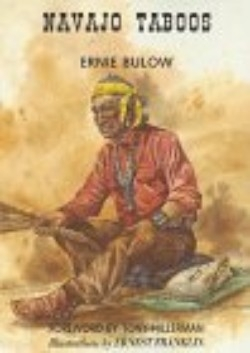Navajo Taboos
The “Navajo Way”—espoused in the popular mystery novels set in Navajoland by Tony Hillerman, who introduces this volume—describes tribal members who are self-deprecating and generous, who believe in moderation in all things, even at the expense of winning, and who value their personal relationships more than material wealth.
Ernie Bulow, while not Navajo himself, grew up in southern Idaho, where he worked with Navajo farm workers on a daily basis. He came to appreciate their generous spirit and unselfish way of life, and later moved to New Mexico, where he taught at a Navajo high school. Bulow’s students were the first generation not forced to suppress their Native culture, but instead encouraged to study and celebrate their ancestral traditions.
Bulow became interested in Navajo taboos, or hozho, as they were called. The hozho are traditional guides to behavior, helping the Navajo attain, or regain harmony in their everyday lives. Bulow and his students traveled around the vast Navajo Reservation in New Mexico and Arizona, documenting taboos still in general use. The original edition of this collection was printed by the Navajo Tribe as the initial offering in their cultural publications series.
This expanded edition includes more detailed explanations of the taboos themselves, their implications for the understanding of Navajo tribal culture, and comments on the universality of many of these “superficially curious” beliefs. A taboo is defined as a prohibition to some specific behavior seen as going against the natural order, with a second component being an immediate and unavoidable punishment for a violation. Bulow progresses through a comprehensive inventory of taboos which he groups under headings such as Natural Powers (Don’t stare at the moon; don’t walk into a whirlwind), Weaving and the Arts (Nothing should be too perfect), Ceremonies (Don’t talk while the Medicine Man is singing), Animals, Crops, and Behavior during Pregnancy. Just as contemporary collections of Native American paintings, pottery and weavings are increasingly being reclassified from “artifacts” to “art,” so may the taboos in this informative book be described not as “curious cultural artifacts,” but as “the defining principles of Navajoness,” by which behavior may be codified and circulated among tribal members.
And just as recent attempts by numerous tribes to record and preserve their languages for future generations are succeeding by involving young Native Americans in that crucial effort, so Bulow and his students’ documentation of this aspect of Navajo social order will help to ensure its survival in the future. (January.)
Disclosure: This article is not an endorsement, but a review. The publisher of this book provided free copies of the book to have their book reviewed by a professional reviewer. No fee was paid by the publisher for this review. Foreword Reviews only recommends books that we love. Foreword Magazine, Inc. is disclosing this in accordance with the Federal Trade Commission’s 16 CFR, Part 255.

